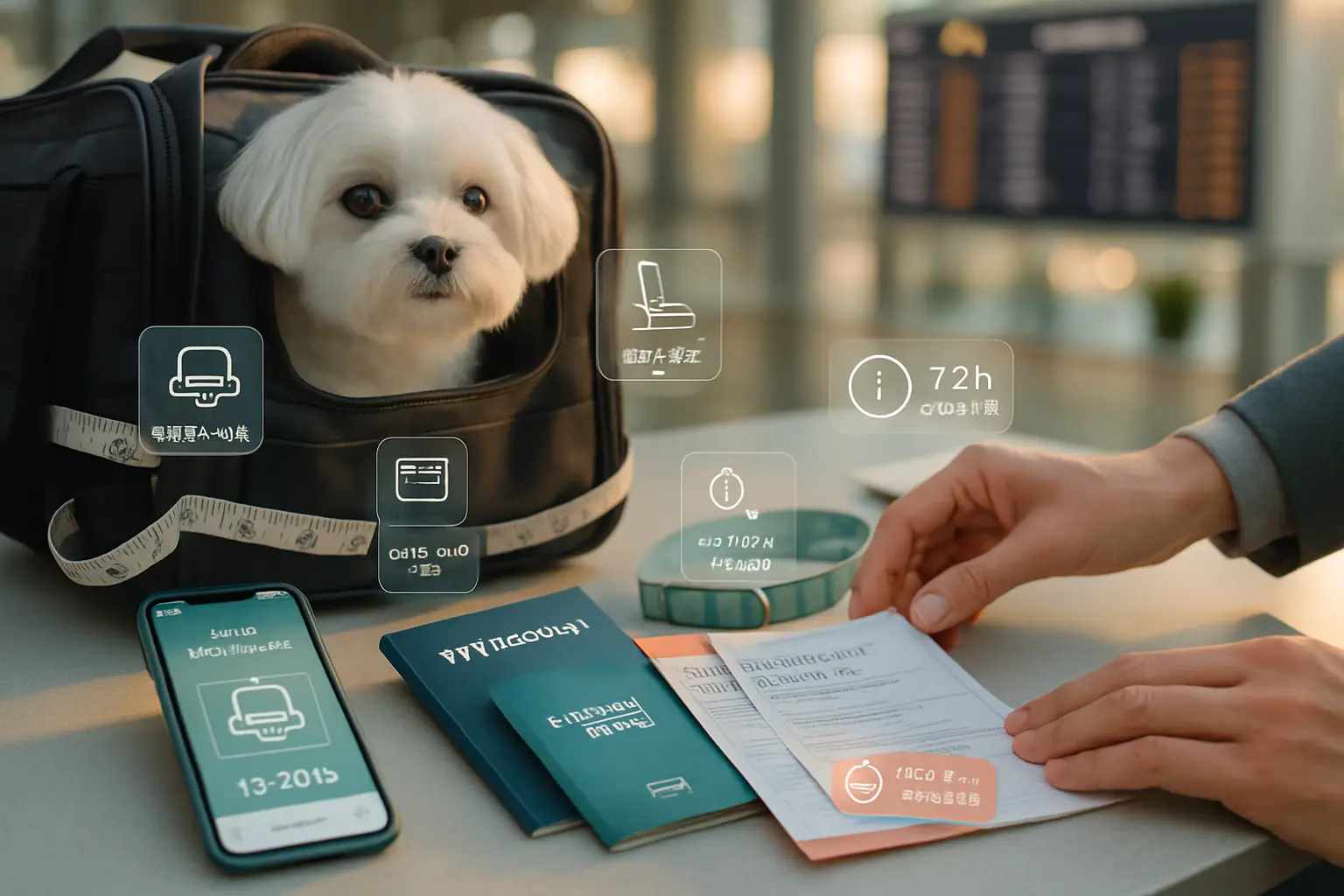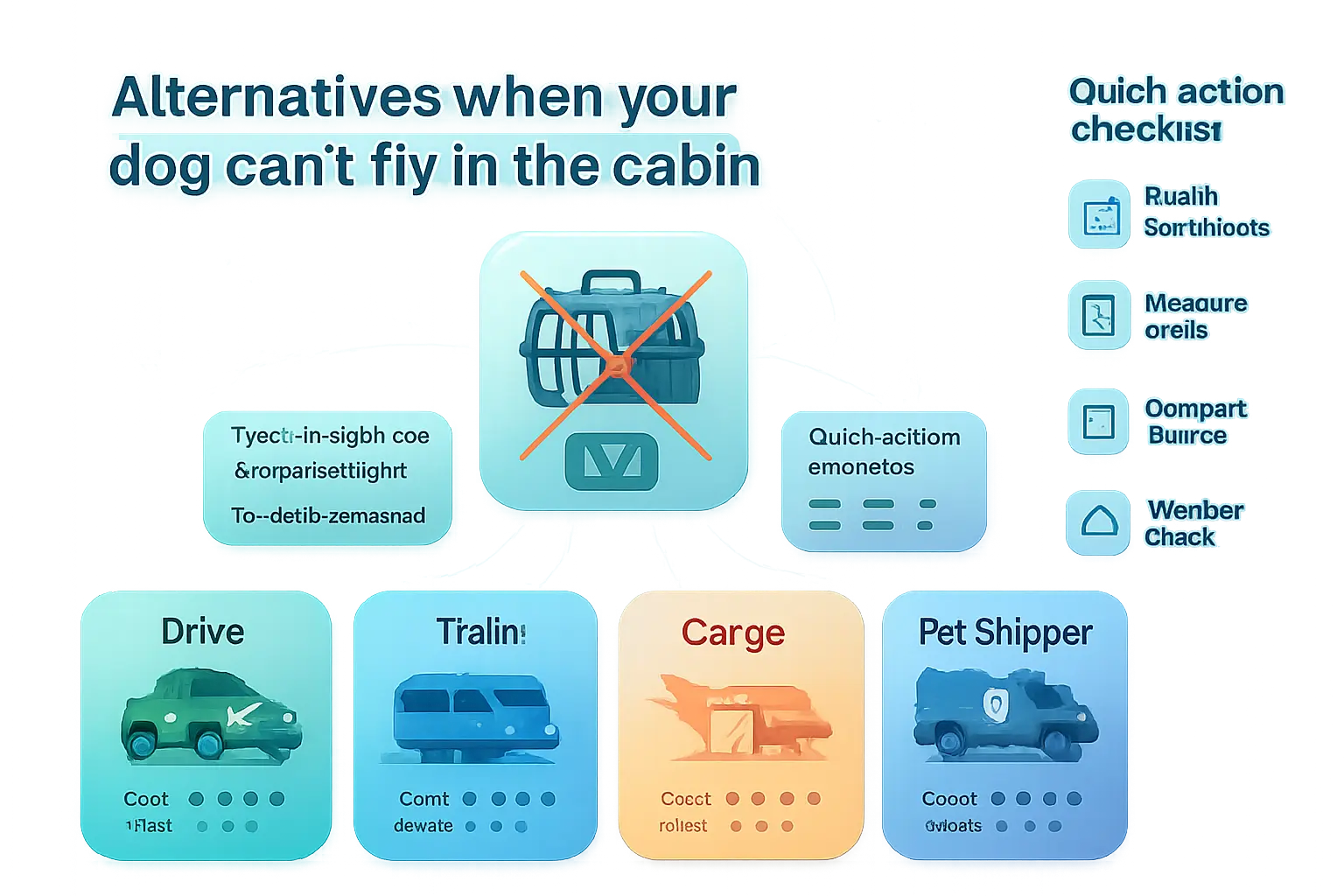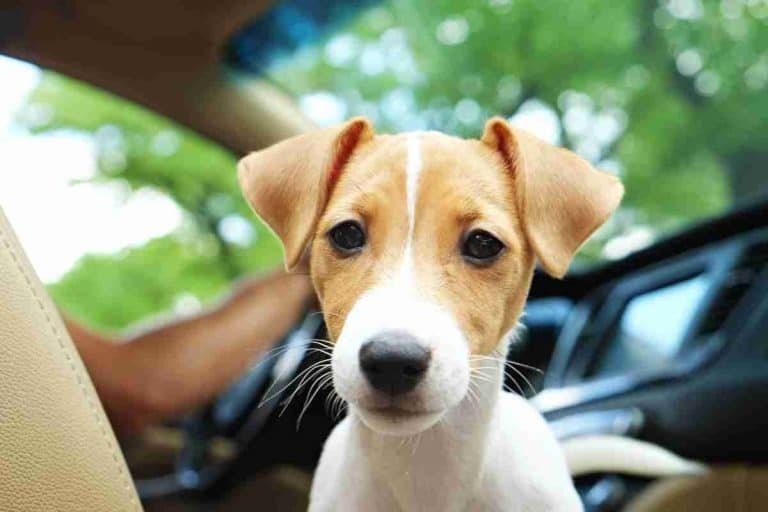15 Dogs You Can Take on a Plane (List with Photos & Airline Tips)
Last Updated on September 15, 2025
Flying with a small dog starts with fit and rules. This guide spotlights 15 dogs you can take on a plane, with photos and practical airline tips. It explains how in‑cabin approval hinges on under‑seat carrier size, combined weight, breed restrictions, and temperament. Travelers see how staff assess quiet confinement, required documents, and typical fees.
Owners also get step‑by‑step prep: measuring a soft‑sided carrier, booking a pet spot, health certificates, and calm‑training. The list pairs each breed with size notes and quick flight tips. It also summarizes major airline policies, day‑of routines, and safe alternatives for larger dogs.
How airlines decide which dogs can fly in the cabin
Airlines evaluate cabin eligibility based on safety, space, and regulatory rules. Policies prioritize passenger comfort and in-flight animal welfare. Carriers require documentation, health clearances, and adherence to size and carrier standards. Staff assess whether a dog can remain confined quietly under the seat for the flight. Fees, route limitations, and seasonal restrictions can affect approval. Travelers should confirm final approval with the airline at booking and again before departure. Check specific carrier rules well ahead of travel to avoid last-minute denial.
Typical size and weight limits and how they’re measured
Most carriers set a combined pet-and-carrier weight threshold rather than a strict dog-only number. Common thresholds fall between about 15 and 20 pounds, though some airlines accept larger cabin dogs. Measurement focuses on whether the carrier fits under the seat, not just the animal’s weight. Staff may check carrier external dimensions and require the dog to stand and turn comfortably inside. Soft-sided carriers often qualify because they compress to fit under seats. Airlines list exact under-seat dimensions on their sites; owners should compare carrier specs before booking.
Breeds commonly restricted (brachycephalic, “dangerous” lists) and exceptions
Carriers often restrict brachycephalic breeds because short muzzles increase breathing risks, especially during stress or temperature extremes. Airlines also maintain breed-specific rules for dogs labeled potentially aggressive, such as some bully and guardian breeds. Exceptions occur when a veterinary certificate clears a respiratory condition or when a carrier offers additional safety measures. Policies vary widely, so consult the carrier’s guidance. For information on handling snub-nosed breeds and airline allowances, see airlines that allow snub-nosed dogs.
Difference between service dogs, ESAs, and standard pets
Service dogs trained to perform tasks travel under different legal protections and usually do not require a carrier. Emotional support animals (ESAs) lost many federal flight protections and face airline-specific rules now. Many carriers treat ESAs as standard pets, requiring carriers and fees. Standard pets must occupy the under-seat carrier for the full flight. Airlines may require recent veterinary records, behavior attestations, and advance notice for all categories.
Carrier and under-seat requirements that determine eligibility
Carrier rules determine cabin access as much as the dog’s size. Typical requirements include leak-resistant bottoms, secure closures, breathable sides, and sufficient internal space for sitting and turning. Airlines often require soft-sided carriers for better under-seat fit. Gate agents may inspect carriers for dimension compliance and pet comfort. The dog must remain inside the carrier from boarding through disembarkation. Confirm carrier dimensions and documentation with the airline before booking to reduce surprises at the gate.
What to check before you plan to fly with your dog
Before booking, owners should verify airline-specific rules for pets. Policies vary on cabin versus cargo travel, carrier dimensions, weight limits, and breed restrictions. Confirm fees, reservation caps for in-cabin pets, and whether the carrier must fit fully under the seat.
Gather required paperwork early: current vaccinations, a recent health certificate, and any destination-entry documents. Microchip information and up-to-date ID tags speed reunification if a dog becomes separated. Check seasonal travel embargoes; some carriers restrict pets during extreme heat or cold.
Measure the dog and test carriers at home for comfort and ventilation. Book flights with minimal layovers and choose non‑peak travel times to reduce stress. For more gear and prep ideas, consult essential dog travel tips and gear for road trips. Strong planning reduces day-of surprises. Owners should confirm policies again 48 hours before departure and print or download all documents to present at check-in.
Temperament and training: is your dog calm enough for a flight?
Assess behavior under mild stress before committing to air travel. A dog that panics in new environments will likely struggle at airports and on planes. Owners should evaluate crate tolerance, response to loud noises, and ability to remain quiet for hours.
Practice crate training with progressive durations and simulate airport stimuli. Short trial car rides followed by brief flights or cabin-like exposures help identify triggers. Teach basic commands — sit, stay, and settle — and reinforce calm behavior with treats and praise.
Address travel anxiety proactively with training and non‑prescription calming techniques. For owners seeking natural methods to reduce nervousness, see 9 natural ways to remedy your dog’s travel anxiety. Avoid sedatives unless a veterinarian prescribes them; many airlines prohibit sedated pets, and drugs can impair thermoregulation and breathing at altitude.
Age, health and medical conditions that affect travel eligibility
Airlines commonly set minimum age limits for puppies, often eight to twelve weeks, and require proof of vaccination. Very young, very old, pregnant, or medically fragile dogs face higher risk during air travel. Owners must consult a veterinarian to confirm fitness to fly.
Request a health certificate within the airline’s required window before departure. Note breed‑specific considerations: brachycephalic (short‑nosed) breeds often carry airway and heat‑regulation risks and may face additional restrictions or bans on certain flights. Chronic conditions like heart disease or advanced respiratory issues typically disqualify in-cabin or cargo travel.
If pregnancy is a factor, seek veterinary guidance about timing and risk. For related travel‑safety guidance, review can a pregnant dog travel by car. Schedule a pre‑travel exam and obtain written clearance when required. When in doubt, postpone travel until the dog receives a clean bill of health.
Grooming, shedding and seasonal considerations (heat risk)
Grooming impacts comfort and safety during flights. Trim nails to prevent carrier damage and discomfort. Maintain a well‑brushed coat to reduce shedding in confined spaces. For long-haired breeds, a tidy trim around paws and rear areas limits matting and odors.
Heat poses the greatest seasonal threat. Choose breathable carriers and never place dogs in cargo during high temperatures. Airlines sometimes enforce heat embargoes for specific breeds and routes; confirm those restrictions before booking. Use cooling strategies pre‑flight, such as a chilled mat or wet towel in supervised settings, to lower core temperature.
Plan pre‑flight hydration and avoid heavy exercise immediately prior to boarding. For ideas on keeping dogs cool during travel days, owners can reference 10 refreshing puncture-proof dog pools. Always monitor a dog for signs of overheating and consult airport staff or a veterinarian if any concern arises.
15 dogs you can take on a plane (photo-ready picks and quick tips)
This curated list highlights small, cabin-friendly breeds that suit airline rules and busy travel days. Each entry names typical size, a travel-strength, and one practical tip to keep flights calm and compliant. Travelers should check specific airline carrier dimensions and health rules before booking. A brief CTA: confirm carrier dimensions with the airline when reserving the flight.
Chihuahua — typical weight, why ideal for cabin travel, carrier tip
Chihuahuas usually weigh 2–6 pounds and fit easily under seats. Their compact size reduces airline restrictions and makes short hops simple. Advise a soft-sided carrier with breathable sides and a non-slip bottom. For guidance on breeds that fit under airline seats, see dog breeds that fit under airplane seat.
Yorkshire Terrier — travel temperament and seat/under-seat fit
Yorkshire Terriers stay calm when properly socialized and tolerate laps well. Typical weight of 4–7 pounds helps them meet most airline cabin limits. Use a carrier that slides fully under the seat to avoid gate checks. For carrier recommendations and crate options, consult best dog crates for car travel.
Pomeranian — calming strategies and grooming note for flights
Pomeranians often carry a fluffy coat that can trap heat. Keep flights comfortable by trimming excess fur around the face and using calming routines before boarding. Gentle ear-pressure acclimation helps with takeoff noise and altitude changes; see tips at does flying hurt dogs’ ears.
Shih Tzu — brachycephalic caution, when they’re suitable
Shih Tzus are brachycephalic, so they risk breathing stress in warm, crowded cabins. Airlines sometimes restrict snub-nosed breeds on longer flights. They suit short, cool flights when healthy and monitored. Review airline policies for snub-nosed dogs at airlines that allow snub-nosed dogs.
Maltese — size, low-shedding benefits, carrier comfort tips
Maltese typically weigh 4–7 pounds and shed minimally, which helps allergy-sensitive seats. Use a padded carrier with soft bedding to prevent slipping and reduce stress. Natural calming techniques before travel reduce whining. See calming remedies at 9 natural ways to remedy your dog’s travel anxiety.
Havanese — friendly temperament and long-flight considerations
Havanese adapt well to strangers and busy terminals. Their sociable nature helps during boarding and security. For longer flights, plan frequent hydration and brief in-car potty practice before heading to the airport. For broader travel logistics, consult traveling with your dog by train tips and tricks.
Bichon Frise — travel temperament and exercise needs preflight
Bichons handle cabin travel when exercised beforehand. A 20–30 minute walk before check-in reduces barking and restlessness. Pack a small absorbent pad for airport delays. For general travel gear and prep, see essential dog travel tips and gear for road trips.
Toy Poodle — hypoallergenic advantage and crate training tip
Toy Poodles often suit allergy-aware travelers thanks to low shedding. Crate training several weeks ahead builds tolerance for the carrier. Short, positive sessions with treats and familiar bedding prepare them for confined cabin time. For reducing vocal stress on flights, see dog whining on plane.
Miniature Dachshund — sizing and calming strategies for carriers
Miniature Dachshunds usually weigh 8–11 pounds; some airlines accept them if under limits. Offer a long, low carrier so the dog can stretch. Calming strategies include preflight walks and chew-safe toys. For carrier transition ideas, refer to how to transport a puppy in a car without a crate.
Cavalier King Charles Spaniel — motion-sickness and seating tips
Cavaliers can suffer motion sickness. Feed a light meal hours before travel and avoid greasy treats. Request a window-adjacent under-seat area for better airflow. For motion-sickness handling in pets, consult no more doggie dramas about motion sick pups.
Papillon — small size, energetic needs, and in-cabin exercise ideas
Papillons need short bursts of activity before flights to reduce restlessness. Use a leash break in a secure area near the terminal for 10–15 minutes. Bring lightweight toys for low-key stimulation inside the carrier. For barking and etiquette guidance, see what happens if my dog barks on a plane.
Brussels Griffon — compact build and acclimation advice
Brussels Griffons remain compact and usually weigh under 12 pounds. Gradual carrier acclimation prevents travel anxiety. Practice short, real-world trips and reward calm behavior. For managing bathroom logistics on flights, reference how do dogs go to the bathroom on a plane.
Miniature Schnauzer — temperament, weight range and preflight prep
Miniature Schnauzers weigh 11–20 pounds; confirm airline weight limits before booking. They travel well when exercised and groomed. Secure the carrier base and include a familiar blanket. For crate security tips useful before flights, visit 5 ways to secure a dog crate in car.
Japanese Chin — lap-friendly breeds and carrier positioning
Japanese Chins enjoy close contact, making lap time during boarding calming. Position the carrier where the dog can see the owner to reduce anxiety. Gentle, frequent short trips help with acclimation. For techniques to get a pet used to travel spaces, see dog refusing to get into car.
Coton de Tulear — calm disposition and long-haul comfort tips
Coton de Tulears combine small size with steady temperaments, making long cabin waits manageable. Add layered bedding for temperature shifts and schedule stretch breaks before security. For airline rule context when booking, check policies like those listed at airlines that allow large dogs in cabin.
How major airlines handle in-cabin dogs (practical summary)
Most major airlines allow small dogs to travel in-cabin when owners use an approved carrier that fits under the seat. Carriers enforce limits on carrier size, number of pets per flight, and acceptable breeds. Airlines expect up-to-date vaccinations and may require a recent health certificate for domestic or international travel. Reservations for a pet spot are often required at booking because airlines cap in-cabin animals per flight. Travelers should confirm whether the carrier counts toward carry-on allowance and whether breed-specific or temperature-based travel restrictions apply.
Quick rules for top US carriers (Alaska, American, Delta, United, Southwest)
Each U.S. carrier enforces the under-seat rule and limits pets per cabin row or flight. Alaska, American, Delta, United and Southwest require reservations for pets and accept only well-contained, non-aggressive animals. Carriers may refuse heavily snub-nosed dogs during hot conditions. Expect a straightforward check-in process, but always call the airline to hold a pet reservation before finalizing the ticket.
Canadian and European carrier highlights (Air Canada, WestJet, Lufthansa, Air France, Vueling)
Air Canada and WestJet mirror U.S. practices but add international documentation rules for cross-border travel. Lufthansa and Air France permit small dogs in-cabin on many routes, with stricter rules for long-haul and temperature-sensitive segments. Budget European carriers such as Vueling allow pets on select flights but enforce tight size and booking windows. Verify documentation and transit rules for each region.
Options for larger dogs: carriers that sell seats or pet-friendly niche airlines (JSX, La Compagnie, WestJet, Elite)
Some niche and regional carriers offer flexible options for larger dogs—selling an extra seat, offering dedicated pet cabins, or permitting bigger carriers when space allows. Examples to check include JSX, La Compagnie, WestJet and Elite; policies vary widely, so review each airline’s pet program before booking. For more on carriers that handle larger pets, see airlines that allow large dogs in cabin.
Typical fees, per-flight limits and booking best practices
Fees vary by airline and route and appear as a pet travel charge at booking or check-in. Per-flight limits commonly restrict two to four in-cabin pets per flight. Best practices: reserve the pet spot early, choose direct flights, bring a compressible carrier that meets dimensions, pack vaccination records and a recent vet certificate, and acclimate the dog to the carrier well before travel. Call the airline the day before departure to reconfirm the pet reservation and any last-minute weather or operational restrictions.
Preparing paperwork, carrier and health checks before you fly

Preparing a dog for air travel requires coordinated paperwork, an airline-approved carrier and a current health assessment. Owners should confirm whether the dog travels in-cabin or in cargo, since rules, fees and size limits differ by airline. Book the pet spot early; many carriers cap in-cabin pets per flight. Gather identification: microchip number, recent health certificate, and vaccination records. Many destinations also require documentation for re-entry.
A practical checklist speeds airport processing: reservation confirmation, vet certificate, vaccination card, microchip details and a travel carrier that meets the airline’s under-seat dimensions. For additional practical travel gear and packing tips, consult this essential dog travel tips and gear for road trips.
Confirm carrier dimensions against the airline’s published limits before purchase. If the airline allows only soft-sided carriers in cabin, choose a breathable model with a secure zipper and a leak-proof base. Always reconfirm pet policies 72 hours before departure to avoid last-minute surprises.
Veterinary checks, health certificates and vaccination timelines
A licensed veterinarian must examine the dog within the timeframe the airline or destination requires. Most airlines accept a signed health certificate dated within 7–10 days of travel for domestic flights. International travel typically demands stricter timing and additional forms.
Vaccinations must be current. Rabies vaccination often has a lead-time requirement for entry into many countries, so owners should check country-specific rules early. Parasite prevention and general wellness checks help reduce flight stress and health risks.
Ask the vet about documentation specifics, such as certificate formats, signatures and whether the destination needs an endorsed or stamped copy. Keep both paper and digital copies of all records.
For tips on ear pressure and comfort during flight, see does flying hurt dogs ears.
Microchipping, international pet passports and country-entry rules
Microchipping provides permanent identification and often forms part of entry requirements. Ensure the microchip meets the ISO 11784/11785 15-digit standard, or carry your own scanner details and documentation if it does not.
Some regions issue an international pet passport or require an export certificate and endorsed health documents. Rules vary widely: countries differ on quarantine, waiting periods after rabies shots, and acceptable microchip standards. Start research early and register the microchip details with a reliable database.
When traveling internationally, check embassy or agricultural ministry websites for the latest entry conditions. If the destination requires additional testing or permits, schedule appointments promptly to avoid delays.
Airline restrictions can interact with country-entry rules, so confirm both sets of requirements before booking. For airline-specific allowances and limits, review airlines that allow large dogs in cabin.
Choosing and measuring the right carrier (soft-sided vs hard-sided)
Measure the dog before buying a carrier: length from nose to tail base and height to the shoulder. Add a few inches so the dog can stand, turn and lie down comfortably. Confirm the carrier fits the airline’s under-seat dimensions.
Soft-sided carriers compress slightly to fit under seats and usually qualify for cabin travel on many airlines. They offer ventilation, pockets and lighter weight. Hard-sided crates provide rigid protection and stackability; airlines often require them for checked or cargo travel.
Look for carriers with secure closures, ventilation on multiple sides, and a waterproof or absorbent base. For longer trips, include familiar bedding to reduce stress. For recommendations on sturdy travel crates, see best dog crates for car travel in 2023.
Test the carrier at home. Encourage short acclimation sessions so the dog associates the crate with calmness.
Steps to register your pet with the airline and document checklist
Register the dog with the airline at booking or by calling the reservations desk. Provide breed, weight, carrier dimensions and the dog’s age. Ask whether the pet requires a reservation confirmation number.
Create a concise document packet to present at check-in:
- Signed health certificate and vet signature
- Vaccination records and any required test results
- Microchip ID and registration details
- Photo ID and a recent photo of the dog
- Reservation confirmation and proof of payment for pet fees
Arrive early at the airport to allow time for pet check-in and inspections. Some airlines require visual inspection of the carrier and dog. Reconfirm breed restrictions and any temperature or seasonal embargoes.
When booking, ask the airline representative how they handle barking, late check-ins and stress-related incidents. If they require special forms, request them and return completed copies well before travel.
Day-of-travel and in-flight care to keep your dog safe and calm
Owners should plan the day of travel to reduce stress and meet airline rules. Arrive early, confirm the carrier fits under the seat, and keep vaccination and health paperwork handy. A light walk and a small breakfast three to four hours before departure help prevent nausea and restlessness. Pack a compact travel kit: absorbent pads, collapsible water bowl, a familiar blanket or toy, and copies of certificates. Use calming tools that have proven results for the dog, such as a snug wrap or pheromone spray, rather than sedatives unless a veterinarian prescribes them. Reserve the pet spot when buying tickets and double-check airline size limits and breed restrictions before the flight. For more gear and prep strategies, refer to essential dog travel tips and gear. A firm, predictable routine on travel day helps the dog stay calm and makes handling security, boarding, and any unexpected delays much easier.
Airport arrival, security screening and relief area strategy
Plan arrival to allow time for a final relief break after security screening. Many airports offer designated pet relief areas past security; locate them on the airport map before departure. At the security checkpoint, expect to remove the dog from a soft carrier while the carrier passes through X-ray. Keep the dog on a short leash or harness for control during screening. Use absorbent pads inside the carrier for accidents and bring spare pads in an easy-access bag. If the dog shows signs of stress, pause for a short walk in a quiet terminal zone to redirect energy. For guidance on handling restroom needs during flights, see how dogs go to the bathroom on a plane. Clear ID on the collar and a harness with a travel tag speeds reunification if separation occurs. A calm, confident handler helps the dog pass screening smoothly and reach the gate relaxed.
Boarding, stowing the carrier and seat selection tips
Choose seats that best match the dog’s needs and the carrier size. An aisle seat allows quicker access for short walks and easier deplaning. Avoid bulkhead seats if the airline instructs carriers to remain fully stowed under the seat in front; some bulkheads lack the required under-seat space. Use a soft-sided carrier that compresses slightly to fit beneath most seats, and test the carrier in advance. During boarding, keep the dog inside the carrier and carry the carrier by the handles or a shoulder strap to reduce jostling. Gate-check only when necessary—under-seat stowage keeps the pet with the owner and reduces stress. Review breed and size fit recommendations to match carrier choice and seating: dog breeds that fit under airplane seat. Reserve seats early to secure the best location for comfort and safety.
In-flight feeding, hydration and dealing with whining or motion-sickness
Feed a small meal several hours before boarding to lower the risk of motion sickness. Offer water up to boarding and provide sips during the flight with a collapsible bowl. Avoid heavy foods or new treats on travel day. If the dog vomits or shows persistent nausea, notify the flight attendant; consult the veterinarian about anti-nausea medication before travel. For whining, owners should respond calmly but sparingly—excessive soothing can reinforce the behavior. Provide a safe chew or lick mat to occupy the dog and encourage relaxation. Use a familiar blanket and a quiet, low-tone voice to reassure without rewarding distress. For tips to stop in-flight whining and soothe anxious pups, see dog whining on plane. Monitor hydration and breathing throughout the flight and act quickly if signs of distress appear.
What to do if there’s an emergency or seatmate complaint
Remain composed and follow airline crew instructions if an emergency arises or a passenger complains. Secure the dog in its carrier immediately and explain calmly what steps are being taken. Keep health certificates and veterinary contact details accessible for crew review. If a seatmate complains about barking, apologize briefly and offer to move the carrier slightly away or switch seats if space allows. For an aggressive incident or a bite, isolate the dog and notify crew to complete incident procedures. For barking-specific policies and mitigation steps, consult what happens if my dog barks on a plane. If the dog requires urgent medical attention, request medical assistance from crew and arrange for immediate care upon landing. Clear, cooperative interaction with airline staff minimizes escalation and helps resolve complaints quickly.
Alternatives when your dog can’t fly in the cabin

When an airline denies in-cabin travel, owners need practical, safer alternatives that match the dog’s size, health and temperament. Ground transport often proves the simplest choice for short to medium distances. For longer trips, consider professional pet shippers and specialized carriers that handle paperwork and climate-controlled vehicles. Private-charter flights and pet-specific airlines provide a calmer environment for anxious or large dogs, though they cost more.
Owners should weigh cost, travel time and the animal’s stress levels. Paperwork and veterinary clearances vary by mode and destination. Book early to secure appropriate crates or reserved cargo spaces. For owners planning road travel instead, resources on essential dog travel tips and gear for road trips explain crate sizing, rest-stop strategies and safety restraints.
Quick action checklist: confirm health certificates, measure the dog for a compliant crate, compare quotes from pet shippers and verify weather restrictions. A clear plan reduces delays and prevents last-minute refusals at check-in.
Checked baggage, cargo or professional pet transport pros and cons
Checked baggage and cargo move large dogs when cabin space won’t work, but each option carries distinct risks and benefits. Checked baggage sometimes exposes pets to temperature or handling variations. Cargo compartments on modern airlines often include pressurization and heating systems, but conditions still vary between carriers and aircraft types.
Professional pet transporters provide door-to-door service, handling crate standards, permits and airline coordination. They reduce owner stress and often include health monitoring. Downsides include higher cost and the need to vet providers carefully. Owners should request airline cargo photos, tracking updates and evidence of climate control.
- Pros: available for large breeds, specialized handling options, professional paperwork support
- Cons: higher stress risk for some dogs, variable handling standards, extra fees
Before choosing cargo or a shipper, review airline-specific cargo rules and the carrier’s safety record. The guide on airlines that allow dogs in the cargo helps compare policies and seasonal restrictions.
Private-charter and pet-specific airlines as a safer option for large dogs
Private-charter flights and pet-focused airlines prioritize animal welfare over passenger logistics. They allow flexible crate sizes, limit the number of animals on board and often use cargo areas dedicated to pets. Many operators accept veterinary monitors or owners onboard with large dogs, cutting separation stress.
Costs run significantly higher than commercial options, but safety improvements can justify the price for brachycephalic, elderly or medically fragile dogs. Operators typically require advance vet checks and tailored transport plans. Request documentation on temperature controls, staff training and emergency protocols before booking.
When comparing carriers, ask about aircraft type, cabin/cargo pressurization and contingency plans for delays. For owners seeking airlines that relax size restrictions or offer special accommodations, the resource on airlines that allow large dogs in-cabin clarifies which carriers provide more flexible policies and when chartering might be the safer choice.
Non-flying choices: driving, train routes and international quarantine workarounds
Non-flying travel often reduces risk and logistical headaches. Driving allows full control of stops, temperature and feeding. For cross-country moves, owners can plan multi-day itineraries with overnight pet-friendly lodging and rest breaks to reduce motion stress.
Some train services accept dogs and prove a calm alternative for certain routes. Trains avoid airport crowds and extreme cargo handling. Routes and rules vary by country and provider, so early reservations and crate compliance remain essential.
For international moves, quarantine rules sometimes force extended holds. Owners should explore direct flights to countries with straightforward import rules or look into approved transport facilitators who navigate quarantine requirements. Practical tips for rail travel and logistics appear in traveling with your dog by train tips and tricks, which covers carrier dimensions, booking policies and onboard behavior expectations.
CTA: owners planning non-flight travel should compare time, cost and the dog’s tolerance for confinement before booking.
Common questions from pet parents about flying with dogs
Pet owners often ask practical questions before booking flights. Clear answers reduce stress and help choose the safest travel option for the dog.
Can I take my dog out of the carrier during the flight?
Airline rules almost always prohibit removing a dog from its approved carrier while the cabin door is closed. Flight attendants enforce this for safety and to avoid disturbance to other passengers. Short exceptions occur during boarding or deplaning, when crews allow brief carrier removal in the gate area. For medical reasons, airlines require documentation and advance approval. To reduce a dog’s anxiety, train them to stay calm inside the carrier before travel and provide familiar-smelling bedding.
How much will it cost and can I buy an extra seat for my dog?
Most U.S. airlines charge an in-cabin pet fee that ranges widely. Fees apply per flight segment and depend on carrier and dog size. Buying a second seat for a dog rarely works; airlines generally require dogs to remain in carriers that fit under the seat. Larger dogs may need to travel as checked baggage or in cargo, which incurs different fees and stricter rules. Always confirm fees and seating restrictions directly with the airline when booking.
Are certain breeds banned from flying or the cargo hold?
Many carriers restrict brachycephalic (short-nosed) breeds from cargo and sometimes from cabin travel during hot months. Airlines also impose temperature and seasonal embargoes. Check breed-specific policies before booking, and consult a veterinarian about breathing risks during air travel.
When to choose an alternative to flying with your dog?
Consider ground or rail travel if the dog is very young, elderly, pregnant, severely anxious, or a brachycephalic breed. Long layovers, extreme temperatures, or airlines that refuse the breed also justify alternatives. For options and practical tips on non-air travel, see traveling with your dog by train: tips and tricks. Book a trial trip by car or train before committing to longer travel.
Summary
This guide spotlights 15 photo-ready, cabin-friendly dog breeds and the airline rules that determine who can fly under the seat. It explains how carriers judge eligibility by under-seat dimensions, combined pet-and-carrier weight, and behavior, with special notes for brachycephalic breeds and the distinctions among service dogs, ESAs, and standard pets.
Travelers also get step-by-step preparation: measuring and choosing a compliant soft-sided carrier, booking the pet spot early, gathering veterinary documents and microchip details, and training for calm, quiet confinement. Day-of strategies cover security screening, seat selection, feeding and hydration, and handling complaints or emergencies—plus practical alternatives when cabin travel isn’t a fit.
Key Takeaways
- Fit beats weight: Airlines prioritize whether a dog in its carrier fits under the seat and can stand, turn, and lie down; typical combined weight limits run about 15–20 lb but vary by carrier.
- Book early and reconfirm: Reserve the in-cabin pet spot at ticketing, then reconfirm policies and the reservation 48–72 hours before departure; caps per flight are common.
- Choose the right carrier: Measure the dog, compare to airline under-seat dimensions, and favor a soft-sided, ventilated, leak-resistant carrier with secure closures; test and acclimate at home.
- Prep health and documents: Obtain a timely health certificate, keep vaccinations current (rabies timing matters internationally), and carry microchip info and printed/digital copies.
- Train for calm travel: Build carrier tolerance with progressive sessions, exercise before check-in, feed a small meal 3–4 hours pre-flight, and use proven calming tools; avoid sedatives unless a veterinarian prescribes them.
- Know limits and alternatives: Expect tighter rules for snub-nosed breeds and hot weather; consider climate-controlled cargo, professional transport, or pet-friendly niche airlines when cabin travel isn’t possible.
FAQ
- What size dog can fly in the cabin? Eligibility depends on the carrier fitting fully under the seat and the dog being comfortable inside. Many airlines use a combined pet-and-carrier limit around 15–20 lb, but dimensions and policies vary—always confirm specifics with the airline.
- How should owners choose the right carrier? Measure length (nose to tail base) and height (to shoulder), add a couple of inches, and match those numbers to the airline’s under-seat dimensions. A soft-sided, well-ventilated, leak-resistant carrier with secure zippers is usually best for in-cabin travel.
- Why do airlines restrict brachycephalic and certain breeds? Short-nosed dogs face higher breathing and heat-stress risks, especially during warm weather or stress, and some carriers maintain additional behavior-based restrictions. Airlines may add seasonal embargoes, so policies need to be checked before booking.
- How can a dog stay calm and quiet on the plane? Gradual crate training, pre-flight exercise, a familiar blanket, and approved calming aids help; offer a small meal hours before departure and water in sips. Address whining with calm, minimal attention and a safe chew to avoid reinforcing the behavior.
- What documents are required for travel, especially internationally? Most trips require a recent health certificate and up-to-date vaccinations; international routes may add rabies waiting periods, microchip standards, and pet passports or export certificates. Keep paper and digital copies and register the pet with the airline in advance.







